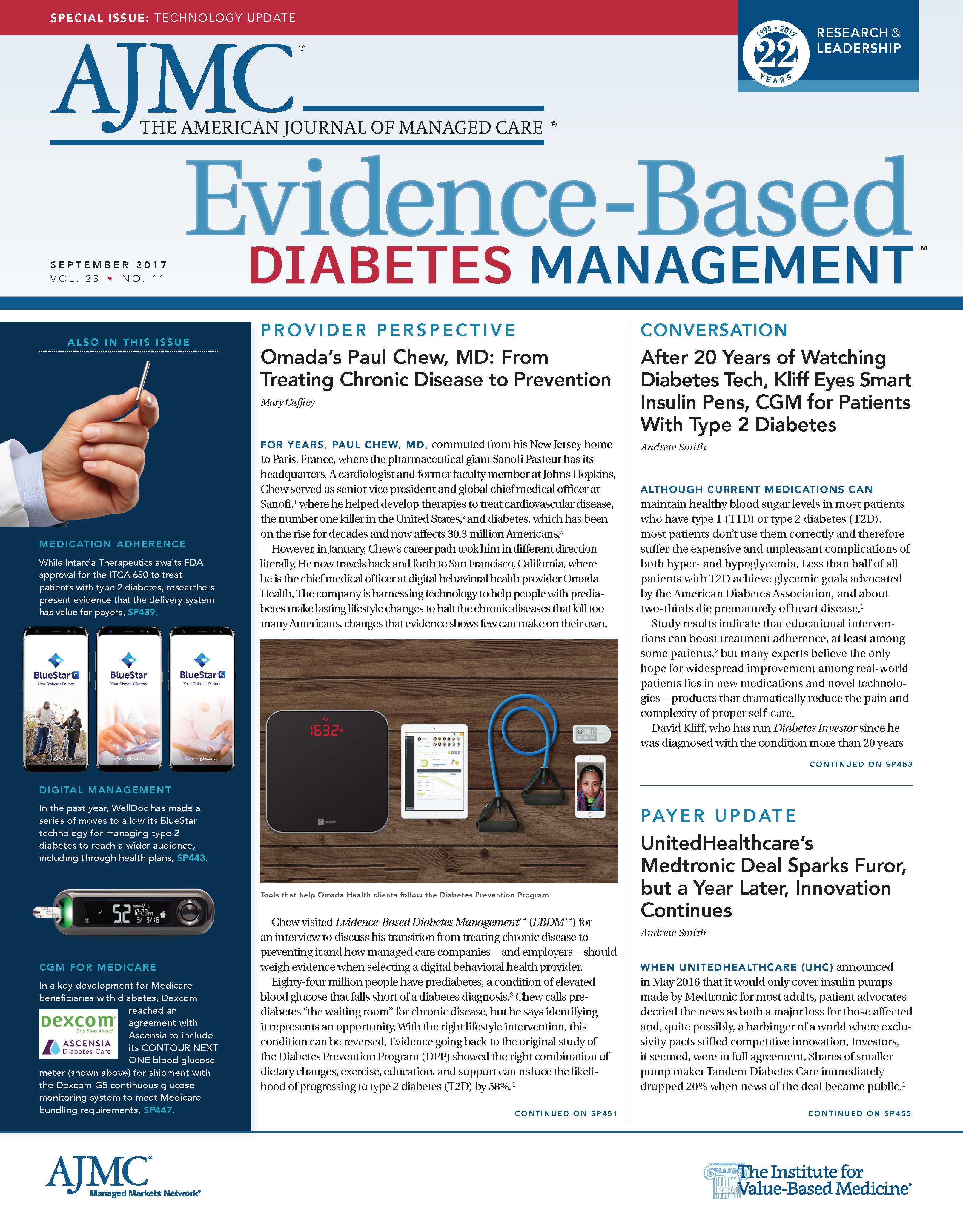Publication
Article
Evidence-Based Diabetes Management
Digital Providers to Comment on Proposed CMS Limits for Medicare DPP Launch
Author(s):
Without digital health providers, Medicare's Diabetes Prevention Program could have a hard time reaching seniors in rural areas, where rates of the disease are approximately 17% higher, one leading provider argued recently.
From the moment word came that Medicare would pay for the Diabetes Prevention Program (DPP), digital health providers have been eager to reach the 23 million seniors with prediabetes.1,2
Many digital health providers have evidence their programs work just as well as face-to-face sessions, and industry leaders say CMS needs them to make a dent in diabetes care and management.3,4
No one blinked in June when a CMS official warned the original January 1, 2018, start date might be pushed back.5 But what came next was a shock: on July 13, 2017, CMS proposed a Medicare DPP model that limited digital (or virtual) providers to giving makeup sessions only, all but leaving these providers out of one of the most important preventive health initiatives that Medicare has undertaken.6
Specifically, CMS proposed in the 2018 Physician Fee Schedule (PFS) that seniors must enroll in a traditional, in-person DPP program and that digital providers can only be paid for up to 4 make-up sessions. Although final comments are not due until September 11, 2017, as Evidence-Based Diabetes Management™ (EBDM™) went to press, published statements and interviews suggest digital providers will argue the proposal hurts seniors who live in the wrong places.
In fact, access could be especially poor in areas where diabetes rates are highest, based on CDC data.7 Study results published earlier this year show this mismatch has already played out with
diabetes self-management education and support programs. Unless CMS changes course, digital providers say, this could be repeated with the DPP when it launches April 1, 2018.6,8
The losers will be seniors and taxpayers, Omada Health CEO Sean Duffy argued in a recent commentary. “Diabetes and diabetes-related treatment is one of the biggest drivers of rising health care
costs for every payer—with Medicare spending more on treating those with the disease every year. This is particularly true in rural America, as the prevalence of diabetes and coronary heart disease
is approximately 17% and 39% higher in rural areas than urban areas,” he wrote for Morning Consult.9
The DPP is a yearlong, evidence-based lifestyle program with a CDC-approved curriculum; it features 16 weekly core sessions, followed by a maintenance period of monthly sessions. Evidence shows the program stops prediabetes from progressing as participants make modest changes and lose 5% to 7% of body weight. In a landmark study by the National Institutes of Health, the program showed a 58% reduction in participants progressing to diabetes.10 HHS’ decision to offer DPP in Medicare followed a successful pilot program the Center for Medicare & Medicaid Innovation (CMMI) conducted with the YMCA, which showed a savings of $2650 per beneficiary over 15 months.1 The finding showed that DPP could help Medicare slow spending on diabetes, which currently consumes $1 of every $3 Medicare spends.11
Letting in-person programs form partnerships with digital providers for make-up sessions could be helpful. Evidence shows that once DPP participants miss 2 sessions, the inability to make them up is a chief reason people drop out.12 Some say excluding digital-only programs is a missed opportunity to attract seniors who are unable or unwilling to take part in a weekly, in-person program. For example, most DPP participants thus far have been women, and digital programs may attract more men.13
Neal Kaufman, MD, MPH, founder and chief medical officer of Canary Health, said in a recent interview with EBDM™ that achieving widespread DPP delivery requires both in-person and digital
programs. “Digital is ubiquitous, 24/7. The person doesn’t need to get in their car to get to the appointment. They can access it from the privacy of their home, they can come in for 5 or 10 minutes
if that’s all they have that day, or they can spend an hour or longer if need be,” he said. “It identifies and helps people who don’t like to join groups.”
In the proposal, CMS argues that the CMMI demonstration was based on an in-person program and that a 100% virtual DPP program is untested, at least within Medicare. “Instead, we are considering a separate model under CMS’ Innovation Center authority to test and evaluate virtual DPP services. Our intention is that any separate model test of virtual DPP services would run in parallel with the MDPP Expanded Model. Consistent with our regular practice for Innovation Center models, we would release details on the model test for virtual DPP services separately."6
This argument overlooks the fact that CDC created a process for digital providers to submit data and achieve recognition status the same way traditional programs do. This has allowed digital providers to offer commercial payers and employers proof that their programs meet evidence-based standards and CMS has access to this data.14
The proposed PFS makes other changes that promise more flexibility to Medicare clients—notably a maintenance period that can last up to 2 years if the person meets weight loss and attendance goals. There’s strong emphasis on performance-based payment, with a detailed schedule of fees for different benchmarks. CMS has called for 50% of Medicare payments to be value-based by 2018.6
Anne Woodbury, executive director of the Council for Diabetes Prevention, which represents both digital and in-person providers, said the group will also seek clarity on what happens with DPP
programs that are already included within some Medicare Advantage policies. In an interview with EBDM™, Woodbury said the proposal points up a broader issue within HHS: “How do we maximize
the use of new technology in the delivery of care?”
Old regulatory structures can’t accommodate the levels of innovation that are changing the way care reaches patients, she said. “It’s a real challenge, and Medicare DPP is feeling that friction right now.”
References
1. Caffrey M. Medicare to fund Diabetes Prevention Program, Burwell says. The American Journal of Managed Care® website. ajmc.com/focus-of-the-week/0316/medicare-to-fund-diabetes-prevention-programs-report-says. Published March 23, 2016. Accessed July 14, 2017.
2. Prediabetes fast facts. CDC website. cdc.gov/diabetes/data/statistics/statistics-report.html. Updated July 17, 2017. Accessed August 28, 2017.
3. Caffrey M. How technology can bring diabetes prevention, care to the masses. The American Journal of Managed Care® website. ajmc.com/conferences/pcdc2016/how-technology-can-bring-diabetes-prevention-care-to-the-masses. Published April 9, 2016. Accessed August 28, 2017.
4. Smith T. Physicians praise online diabetes prevention program: “finally.” AMA Wire website. wire.ama-assn.org/delivering-care/physicians-praise-online-diabetes-prevention-program-finally. Published January 31, 2017. Accessed August 28, 2017.
5. Caffrey M. Medicare’s Diabetes Prevention Program is coming, but CMMI has work to do. The American Journal of Managed Care® website. ajmc.com/conferences/ada-2017/medicares-diabetes-prevention-program-is-coming-but-cmmihas-work-to-do. Published June 11, 2017. Accessed August 28, 2017.
6. Proposed policies for the Medicare Diabetes Prevention Program expanded model in the Calendar Year 2018 Physician Fee Schedule proposed rule [press release]. Washington, DC: CMS newsroom; July 13, 2017. cms.gov/Newsroom/MediaReleaseDatabase/Press-releases/2017-Press-releases-items/2017-07-13-2.html. Accessed July 13, 2017.
7. Diabetes county data. CDC website. cdc.gov/diabetes/data/county.html.Updated May 2, 2017. Accessed August 28, 2017.
8. Rutledge SA, Masalovich S, Blacher RJ, Saunders MM Diabetes self-management education programs in nonmetropolitan counties—United States, 2016. MMWR Surveill Summ. 2017;66(10):1-16. doi: 10.15585/mmwr.ss6610a1.
9. Duffy S. CMS must ensure seniors have access to diabetes prevention resources. Morning Consult website. morningconsult.com/opinions/cms-must-ensure-seniors-access-diabetes-prevention-resources/. Published August 14, 2017. Accessed August 16, 2017.
10. Knowler WC, Barrett-Connor E, Fowler SE, et al; Diabetes Prevention Program Research Group. Reduction in the incidence of type 2 diabetes with lifestyle intervention or metformin. N Engl J Med. 2002;346(6):393-403.
11. American Diabetes Association. Economic costs of diabetes in the U.S. in 2012. Diabetes Care. 2013;36(4):1033-1046. doi: 10.2337/dc12-2625.
12. Caffrey M. Solera Health launches mobile app to aid retention in Diabetes Prevention Program. The American Journal of Managed Care® website. ajmc.com/focus-of-the-week/1216/solera-health-launches-mobile-app-to-aid-retention-in-diabetes-prevention-program. Published December 9, 2016. Accessed August 28, 2017.
13. Caffrey M. Solera seeks to be “back office” for community-based diabetes prevention. The American Journal of Managed Care® website. ajmc.com/focusof-the-week/0816/solera-seeks-to-be-back-office-for-community-based-diabetes-prevention. Published August 2, 2016.
14. National Diabetes Prevention Program. Registry of recognized organizations. CDC website. nccd.cdc.gov/DDT_DPRP/Registry.aspx. Accessed September 2, 2017.
Newsletter
Stay ahead of policy, cost, and value—subscribe to AJMC for expert insights at the intersection of clinical care and health economics.







